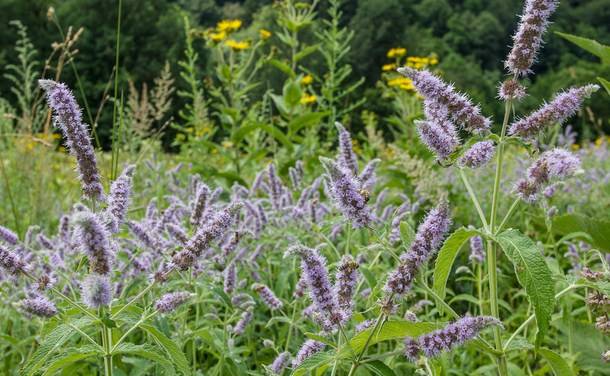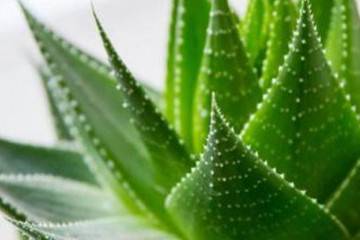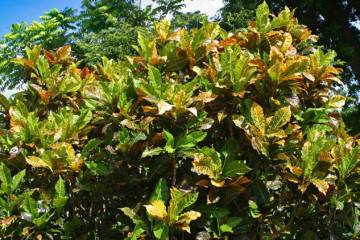What does mint look like - varieties and names
Content:
Many drank mint tea made from aromatic herbs. But few people know that the species of mint are quite numerous. There are wild forms of culture, some are successfully grown in garden plots and in apartments.
What a plant mint
Mint is a plant that belongs to the Lamiaceae family. All species of this culture have an inflorescence similar to an open pharynx. Currently, about 25 varieties of this flower have been studied. The culture is grown and harvested for medicinal purposes, for the preparation of dishes and cosmetics.
General description where it grows in nature
This herbaceous shrub has a straight stem, 20 to 150 cm high, depending on the variety. Branches cover oval leaves up to 8 cm long.
The flowers are collected from the inflorescence and have a purple hue. All types and varieties of mint are distinguished by increased odor due to the high content of menthol. Grass grows in open field plots, on swampy river banks, and can exist in garden flower beds.
Habitat - Mediterranean, Europe and Central Asia. Where mint grows, there is usually high humidity and acidic soil.
It is a perennial or annual plant.
All flower varieties are perennials. However, there are varieties in which the root part and stems that have grown in the current year die off for the winter. Next year, new shoots appear from the daughter roots.
All varieties of mint have stems with a one-year lifespan.
Mint varieties for growing in the country in the open field
In many countries of the world, fragrant grass is grown on an industrial scale. In order to have a mini-pharmacy at your site, you can plant a form suitable for growing in the ground.
These varieties are usually hardy, with a powerful rhizome. The plant reproduces by seeds, crop care is not difficult, the grass does not require shelter for the winter.
Peppermint
The most famous bush variety among gardeners. In general, few people do not know what peppermint looks like.
Bushes grow up to 1 meter tall. Oval serrated leaves grow along the entire length of the stems, on the tops for several months there are blossoming flowers collected in fluffy spikelets.
Pepper grass has a powerful root system, it is very difficult to remove it from the site. The plant perfectly tolerates any frost. Like all varieties of shrubs, this species contains many aromatic oils, carries its aroma several meters from plantings.
Despite the fact that mint, the herb of which is of high importance in medicine and perfumery, some gardeners dislike it.
Menthol mint
The herb is characterized by a high content of menthol, has an intense aroma, and is resistant to pests and diseases.
The menthol form raw materials have tremendous health benefits.It is actively used in cosmetology, cooking, medicine, both traditional and folk.
The herbaceous plant reaches 60 cm in height, its leaves are dark green, elongated, slightly twisted. Flowers are represented by inflorescences of a purple hue.
Lemon mint
This small herbaceous bush up to 30 cm high is prized for its delightful lemon scent and high medicinal properties. The flower juice contains a large amount of essential oils, carotene, vitamin C.
The perennial herb was brought to Russia from southern Europe. The leaves can be brewed, and the tea drink from them has a pleasant sour taste.
Curly mint
The variety has an unobtrusive pleasant aroma of menthol, the crown is used to prepare tea drinks. The height of the grass is from 30 cm to 1 m, the leaves are light green.
Curly mint got its name from the special curly structure of the leaves.
Lofant Anisovy
Perennial is common in the gardens of America, Central Asia, grows in the Crimea. The bush reaches 1.5 m in height, the leaves are oval-pointed, with large notches.
The flowers are collected in inflorescences in the form of an ear, which can be up to 10 cm in size. The way Lofant mint blooms amazes people unfamiliar with this variety.
Due to its rich vitamin composition, Lofant is used in folk medicine to treat various ailments. Raw materials are in demand in cooking, perfumery.
Varieties of mint for growing at home
For lovers of a fragrant flower, there are species adapted to home planting. Caring for these varieties is as simple as for garden forms.
It is important to provide sufficient watering and moisture to the flower.
For home planting of mint, seeds are used. The difference between the home form and the garden form is the smaller size of the bush.
Home mint, or Plectrantus
This type belongs to the decorative varieties. But it is also used in cooking, to repel insects.
At home, the bush can grow up to 5 years. The height of the stems reaches 150 cm, the crown can be formed. The leaves are ovoid, the flowers are collected in umbrellas.
Chocolate mint
A variety with a chocolate, caramel aroma and a brownish, sometimes red shade of the crown, which sometimes reaches black in color.
The herb grows rapidly, reaching a height of 30 cm. The leaves of the chocolate variety have a milder taste than other types.
Raw materials of this grade are used as a flavoring additive in confectionery. The chocolate look shows how unusual mint is.
Ginger mint
A special feature of this variety is the aroma of ginger root. The bush is up to 60 cm high, the leaves are lanceolate, variegated in color. Due to its frost resistance, it can be planted in the ground.
The variety has a high decorative and medicinal value.
Exotic mint varieties
Exotic varieties of mint include rare forms, the raw materials of which are not eaten because of their pungent odor. Rare species that have a limited growing area can also be attributed to this group.
Korean mint
This type of flower has stems that smell like licorice, and the leaves smell like anise. Lush bushes reach 1.5 meters in height. The crown is lush, its parts are eaten.
Peduncles in the form of long shaggy brushes consist of lilac and blue flowers.
Dog mint, or ivy budra
For a strong unpleasant smell, this herb was nicknamed dog. Ivy budra is the second name of the herb.It is called so for the similarity of creeping stems with ivy.
Budra's leaves are round, matte, dark green in color. Small blue flowers grow from the bases of the buds. The flowering of the bush is not wild. Grows in a zone of temperate climate. Raw dog grass is used in medicine and cooking.
Catnip, or Catnip
This species got its name from the cat's cat because of the characteristic smell that attracts cats.
The bush grows up to half a meter, tassels of inflorescences with white-purple flowers crown the tops. The culture blooms at the end of June, the shoots and flowers of this mint are used in cosmetology.
Medicinal properties of mint and contraindications
Mint leaves are suitable for the production of menthol oil, which is used as a bactericidal agent. The bush contains a set of useful elements - fiber, tannins, vitamins C and B, trace elements, carotene, organic acids. The content of essential oil in raw materials reaches 6%.
Various ailments are treated with the use of aromatic raw materials:
- A medicine based on the plant relieves vascular spasms, lowers blood pressure, improves blood circulation, and copes with a runny nose.
- The product helps to solve the problem of urination, has a diuretic effect.
- The plant relieves attacks of nausea, eliminates edema, and helps to cope with asthmatic attacks.
- Herbal infusions are used for bronchitis, pneumonia.
- Women are advised to take medications from aromatic mint to relieve menstrual pain, make soothing infusions.
The medicinal plant also has a number of contraindications, and improper use is harmful. For people with low blood pressure, medicinal tinctures are contraindicated, as they dilate blood vessels.
Varicose veins are also a prohibition against taking herbal medicines. Allergy sufferers can get a reaction even from the scent of the herb.
Men should refrain from taking aromatic tinctures, as they lower libido. People associated with movement and other types of concentration should not take funds based on odorous grass, because its substances have a relaxing effect on the human body.
Common mint, familiar to everyone, has a lot of useful qualities. Raw materials are used to treat all kinds of diseases, it is an indispensable ingredient in cosmetic production and cooking.





















